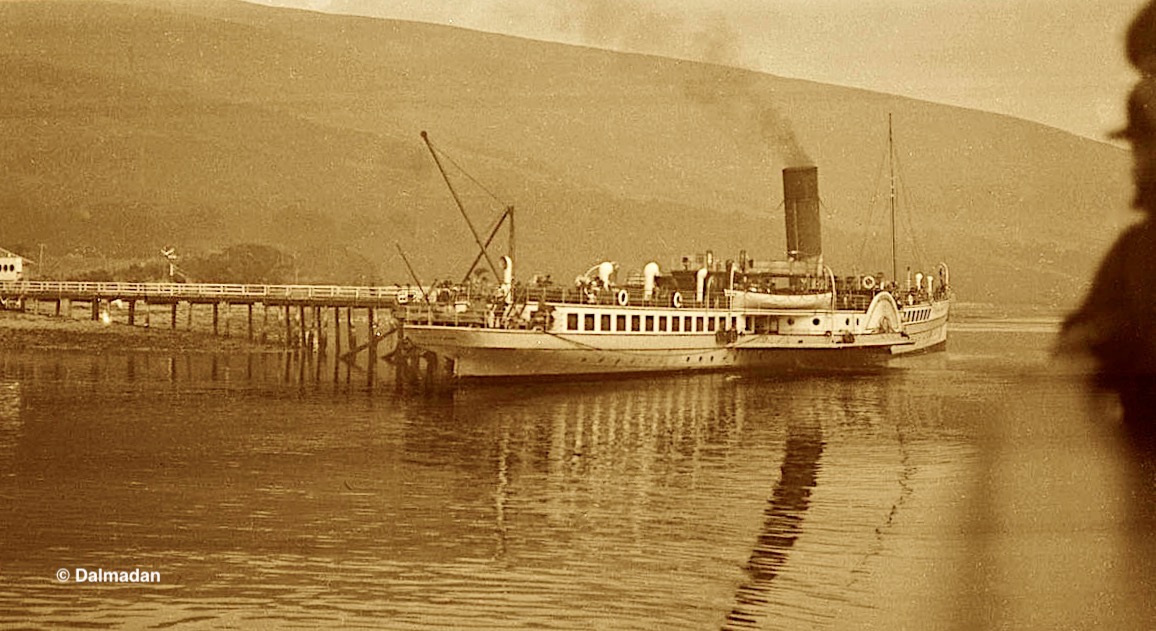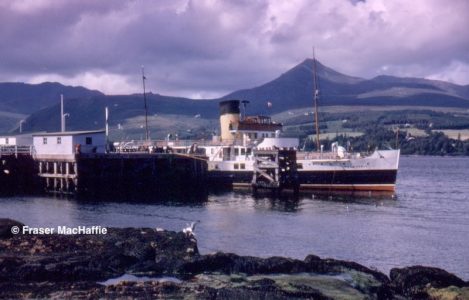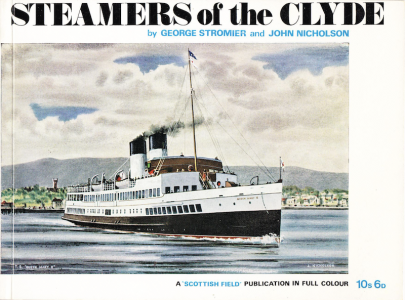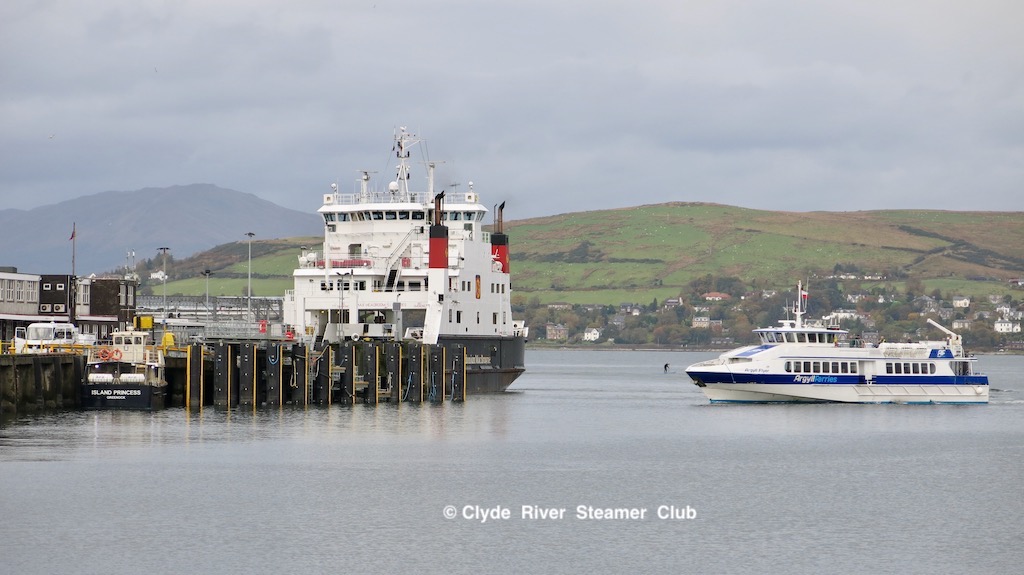
The Glasgow & South Western Railway steamer Juno at Colintraive in August 1913 — one of many photographic gems that Graham Lappin has published on his website Dalmadan. In this instance it was used to illustrate an in-depth study of the origins of Kyles piers
Graham Lappin has won a wide following in the enthusiast community and far beyond through his highly respected website Dalmadan, which comprises dozens of thoroughly researched and beautifully illustrated articles on the history of steamers of the Clyde and Western Isles.
Graham himself is quietly elusive: he writes under the pen name Valeman, denoting his roots in the Vale of Leven, and although a Scot to his fingertips, he has lived for the best part of 40 years in the American state of Indiana, where he is Professor of Chemistry and Biochemistry at the University of Notre Dame.
A CRSC member since his youth and owner of a valuable collection of steamer photographs (which he generously makes available for our magazine ‘Clyde Steamers’), Graham is a worthy subject for the revival of our popular series ‘On the Spot’.
We asked him first to explain the origins of Dalmadan:
“Dalmadan started when I was trying to catalogue my collection but could not incorporate text and pictures very easily on the home computer I had at the time. That was about six years ago (27 October 2014). Combined with links to original newspaper sources that are now available online, I found the research fascinating and thought it deserved a wider audience, so I made it public.
“Around 2010, I had completed an annotated version of an old history, ‘Balloch and Around’ by James Barr, with Graham Hopner who was local history librarian at Dumbarton. We self-published and I needed a name for the publisher. Dalmadan is a made-up word. I was originally trying to get a word that meant ‘field of the mad man’. Despite advice to the contrary, I kept the name for the website.
“I’ve always been frustrated that the tools of history are kept behind lock and key. The best way to create interest is to make material accessible. Dalmadan gets about 100 page hits a day which amazes me. Right now I’m working on an essay on the Greenock and Helensburgh Steamboat Company from the 1860s and 70s. I have lots of projects on the go from puffers to battleships, and I have a ton of material on Rothesay, Millport and Largs to get into at some point. I like the older material as it has not as much written about it. I certainly don’t think the Dalmadan website is a definitive history or indeed any indication of expertise. I rather see it as a platform that might help others to gather information more easily.”
In his responses to our usual ‘On the Spot’ questions, Graham gives an insight into why he loves the Clyde and its steamers.

Caledonia at Brodick c1962, on a sunnier day than that remembered by Graham on one of his early steamer trips
What is your earliest memory of sailing on a Clyde steamer?
Getting a soaking on the upper deck of the paddle steamer Caledonia in Brodick Bay.
What was the most recent sailing you took?
Last time I was in Scotland, on a blustery March day on Argyll Flyer from Gourock to Dunoon. I think I had sailed on her previously in Ireland, on a trip to the Aran Islands. As the weather deteriorated, the ‘Flyer’ was pulled off and I returned on Coruisk. First time on her and was quite impressed.
Holidays: Dunoon, Rothesay or Arran?
Arran. I had an uncle who was a gamekeeper at Dippin with a great view of Pladda and the lower Firth. It was a ship spotter’s dream in the late 1950s and early 1960s.
What is your favourite steamer?
Of all time, probably Madge Wildfire as a steamer that served many masters in many guises. Of those I sailed on, Caledonia. Such a shame she was destroyed on the Thames.
Which was Waverley’s best livery?
Toss up between the WSN and, in my more nostalgic moods, her early Caledonian Steam Packet Company colours with buff funnel and black hull. On balance WSN.
If young enough, what was your favourite ‘streaker’, or if older, your favourite ‘Maid’?
Has to be Maid of Argyll. I grew up in the Vale of Leven and all excursions started at Craigendoran. The ‘Maids’ were fine boats. I did like Pioneer though.
Jeanie Deans or Waverley?
Jeanie Deans. Always exciting to get on board her on the way to Dunoon or Rothesay. Besides, my mother’s name was Jeanie.
A new turbine has been built on the Clyde. What would you call her?
I’d like to say Duchess of Hamilton, but I don’t think royal names have the same appeal nowadays as they had early last century. I’d go with a gaelic name, iolaire (eagle), that has a historical connection to the Clyde.
What would you like to see happen on the Clyde ferry scene over the next few years?
Car ferries are here to stay for the foreseeable future, but with increasing concerns about global warming and the environment, I think there is an opening for short-haul passenger and bicycle traffic, especially as the populace becomes more health focused.
The best point-to-point route you’ve sailed on?
Ardrossan to Arran.
Apart from Millport, which pier would you like to see re-open?
Arrochar. If Maid of the Loch can get sailing again on Loch Lomond this could be a great link.

A series of steamer profiles in the magazine Scottish Field, written by CRSC co-founder George Stromier and illustrated by John Nicholson, was so popular that it was published in book form in 1967 — to the delight of the young Graham Lappin
What inspired you to join CRSC?
Always had an interest in steamers, and the Scottish Field publication ‘Steamers of the Clyde’ captured my imagination. I visited some CRSC exhibitions when I lived in Glasgow and was impressed. Joining the Club seemed like a natural thing to do.
If CRSC had loads of money in the bank, what would you spend it on?
Getting the story out to the attention of the public. The website and other media are excellent at present and interest seems to come and go. Get professional help in placing interesting articles in newspapers and magazines to stimulate interest with links to sailings and meetings. These worked admirably last century and might work again. Put together really good displays and presentations and have members use them in local communities. Link with the Queen Mary folks and construct an entrance building to the ship that houses a permanent exhibition on Clyde steamers.
What makes you continue your membership of CRSC?
I enjoy the magazine and review publications and always look forward to hearing about the lectures that I cannot attend. I’ve managed to get to a couple of Club sailings over the years and really enjoyed them though I’m not the most sociable person. I try to plan at least one steamer related activity when I make a trip to the UK.
What could the Club do better?
The Club does an excellent job for its members. Outreach is important and with the interchangeability of the Clyde and Western Isles vessels, interest has broadened. Preserving the past is admirably done by the Club and is an essential component but there is plenty to look forward to in the future. That should be the focus.

‘I was quite impressed’: Coruisk at Gourock on 31 October 2015, with Island Princess and Argyll Flyer (in Argyll Ferries livery)

Favourite steamer: Madge Wildfire off Gourock in Caley colours c1890. Built for the Campbells of Kilmun in 1886, she became Buchanan’s Isle of Skye in 1913 and served as a ‘doon the watter’ steamer until 1927, when she was sold to the Forth and renamed Fair Maid. Towards the end of the Second World War she was based at Craigendoran. She was broken up at Troon in 1945
Previously ‘On the Spot’ — Jim Stirling, John Beveridge, Andrew Anderson, Paul Semple, Lawrence Macduff and more…..
Joining CRSC is easy: click here.
Published on 3 November 2020













